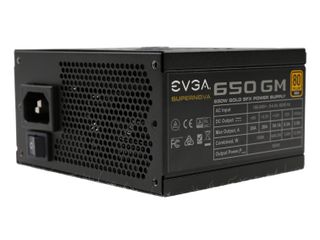EVGA SuperNOVA 650 GM PSU Review: Big Power In A Small Form Factor
Why you can trust Tom's Hardware
Final Analysis
This new FSP platform yields a nice surprise. We've reviewed many PSUs based on the ACRF topology, and up until now, none of them impressed us. Their transient response was lousy , as was ripple suppression and load regulation. But it seems like FSP was able to address almost all of this design's performance issues and introduce a solution able to take on distinguished competitors like the Corsair SF600.
The SuperNova (what a name for a power supply!) 650 GM utilizes FSP's latest ACRF implementation to enable high capacity, improved efficiency, high overall performance, and quiet operation. It's not quite up to the level of Corsair's top-notch SF600, but it does offer an extra 50W of maximum power.

Given all of that, I find EVGA's rookie entry to the tough SFX market interesting, to say the least. We knew that Super Flower was working on its own SFX-based design, so I expected EVGA to embrace that platform. But it appears that SF couldn't finish up quickly enough, prompting EVGA to look elsewhere.
The resulting product of EVGA's and FSP's collaboration offers good performance across our benchmark suite. Our only objection is loose load regulation on the 3.3V rail, which, together with average transient response on the same rail, causes some problems under dynamic loads. Fortunately, that rail isn't heavily utilized, so the platform's shortcoming isn't a deal-breaker.
At least EVGA's SuperNOVA 650 GM is affordable, backed by a generous seven-year warranty, and pleasantly quiet under normal operating conditions.
The list of improvements that we'd suggest for the next version of this model includes:
- Tighter load regulation and improved transient response at 3.3V
- Fine tune the APFC converter in order to offer higher PF readings
- Adjust the power-good signal to exceed 16ms
- Lower the inrush currents (especially with 230V)
- Reduce power consumption in standby
- Offer a selectable semi-passive mode
- A second EPS connector would also be nice
MORE: Best Power Supplies
MORE: How We Test Power Supplies
MORE: All Power Supply Content
Disclaimer: Aris Mpitziopoulos is Tom's Hardware's PSU reviewer. He is also the Chief Testing Engineer of Cybenetics, and developed the Cybenetics certification methodologies apart from his role on Tom's Hardware. Neither Tom's Hardware nor its parent company, Future PLC, are financially involved with Cybenetics. Aris does not perform the actual certifications for Cybenetics.
Current page: Final Analysis
Prev Page Performance, Value, Noise and EfficiencyStay on the Cutting Edge
Join the experts who read Tom's Hardware for the inside track on enthusiast PC tech news — and have for over 25 years. We'll send breaking news and in-depth reviews of CPUs, GPUs, AI, maker hardware and more straight to your inbox.
Aris Mpitziopoulos is a Contributing Editor at Tom's Hardware US, covering PSUs.
